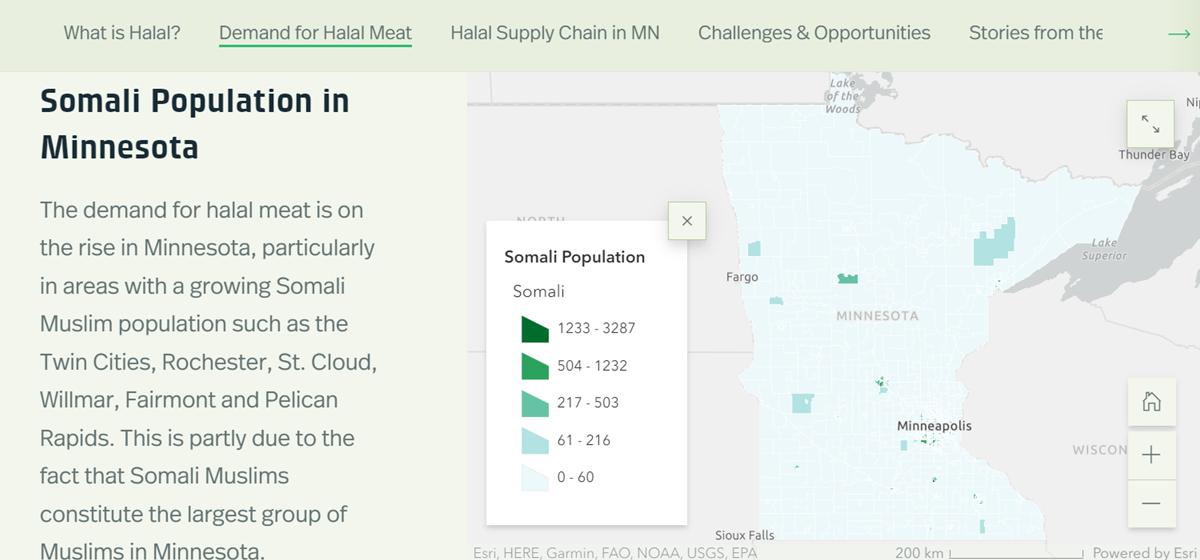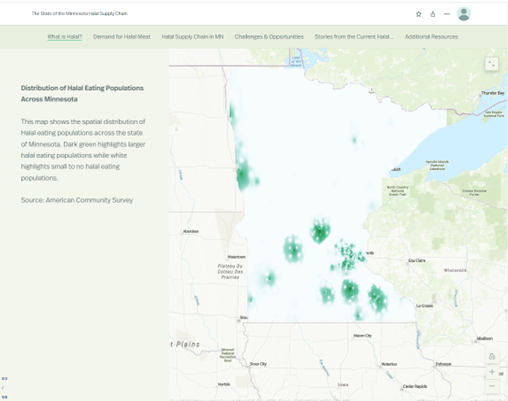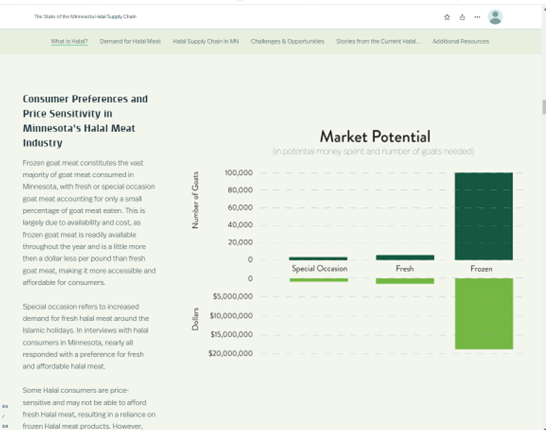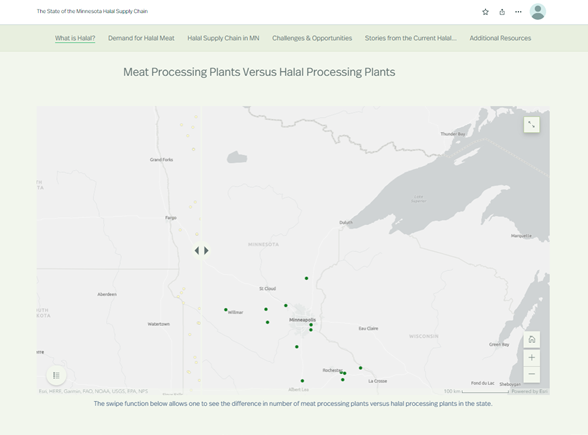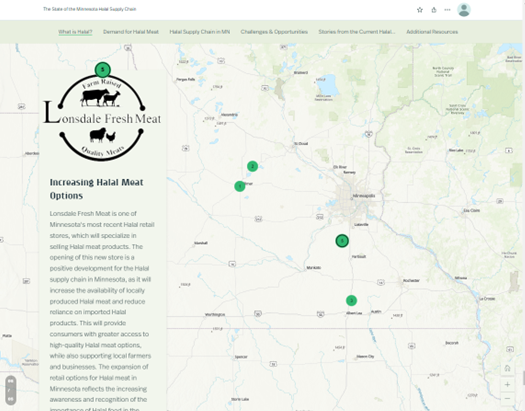Final report for ONC22-112
Project Information
Federal and state efforts to support livestock processing have increased in recent months. COVID-19 outbreaks caused major meat processing facilities to temporarily close in the Upper Midwest, further contributing to a bottleneck in processing that has yet to recede. As new local processing facilities serving small and medium sized livestock operators come online, farmers will have the opportunity to expand or start new flocks. This project will engage such farmers that want to reduce reliance on chemical fertilizers and herbicides and adopt regenerative grazing practices that build soil and increase soil quality such as grazing on perennial pastures, integrating livestock within cropping systems, and utilizing and grazing cover crops.
Furthermore, the project seeks to tie halal meat production and processing to environmental and economic goals. By using a community design framework, this project gathers farmer input and provides community mapping to assist in identifying optimal parameters for a halal processing facility in Central Minnesota. An unmet market demand for fresh halal lamb and goat meat opens business opportunities for tribal and grass-based livestock producers. Supplying the growing population of Muslim Americans and immigrants that seek fresh halal meats is an economic opportunity that supports the culturally relevant nutritional needs and provides short-and long-term opportunities for community economic development.
Objectives
- Convene stakeholders from small-scale pasture based and organic grazing operations; halal livestock producers and processors; and tribal livestock producers
- Build cross-cultural relationships in Greater MN through problem solving
- Conduct design process where stakeholders collaborate to define problems facing livestock production and processing and identify creative solutions
- Utilize a design specialist to document meeting proceedings innovatively, and informatively, and in a format that is accessible to a multicultural audience
- Increased understanding of and strategies for access to meat slaughter and processing
- Generate a community map that identifies optimal locations for a halal processing facility that considers stories told by halal, grass-based, and tribal farming stakeholders; population growth and projections of Muslim Americans and immigrants in Minnesota; and access to potential existing labor pools and meat processing training programs
Cooperators
- (Researcher)
Research
Map Development:
The project team has hired a graduate research assistant (GRA) with expertise in Geographic Information Systems to develop a spatial mapping tool that can demonstrate suitable locations for investors to locate a halal processing facility. Currently the team is working with the GRA to conduct interviews with key stakeholders to identify important layers that need to be included into the mapping framework. So far these include:
Existing halal livestock producers
Existing halal processing facilities
Existing, Active, and Idle meat processing facilities
Locations of large scale meat processing factories
Density of halal consuming populations
Retail sales locations
Transportation networks
Potential Layer: Three phase power access
Potential Layer: 8 inch sewer availability
Potential Layer: Slaughter in city codes
The GRA continues to connect with key informants to gather additional information about data and information needs of potential investors and halal entrepreneurs.
Story Map
The project team is collecting survey and interview data from livestock producers, halal consumers, halal retailers, and other halal stakeholders. The information collected will be curated into a visual story map that provides a geographic depiction of suitable locations to locate halal meat processing facilities along with collections of stories, opinions, and experiences of halal stakeholders.
The team has finished developing a survey tool and is in the process of generating a suitable list of livestock producers that would have an opportunity to expand markets to include halal consumers and retailers. The team will soon connect with networks including Sustainable Farming Association, Minnesota Farmers Union, AURI, the Meat Processing Working Group, Extension, Emerging Farmers Working Group, and others to gain assistance with collecting survey information.
Following survey implementation, the team will conduct isolated interviews with key informants to collect descriptive stories and experiences of halal consumers, retailers, and others.
The overall purpose of this project is to provide publicly accessible information for use by individuals and groups that have an interest in investing in the halal meat supply chain in Minnesota. The project team held discussions and conducted interviews with stakeholders in the halal meat industry including halal livestock producers, meat processors, halal consumers, city planners, tribal livestock producers, sustainable and grass-based livestock producers, and regulatory and industry representatives. The graduate research assistant collected information from primary sources (surveys and key informant interviews) and secondary sources (US Census data, Agricultural Census data, Minnesota Department of Agriculture meat processing database, and previous project reports). Information was decoded and depicted visually using graphic images and mapping via GIS software in a Story Map format. The Halal Supply Chain Story Map summarizes and displays pertinent findings from the project and is available online accessible from this link: https://extension.umn.edu/livestock-operations/halal-friendly-minnesota#halal-supply-chain-story-map-3352962
The following image thumbnails represent pertinent research areas and results within the Halal Supply Chain Story Map.
Somali Muslims in Minnesota constitute a large majority of the states halal consumers. This is relevant as Somalis make up a large portion of the potential market for halal meats as well as the preference of goat meat in Somali culture compared to other population groups that prefer lamb or beef. The map on the left depicts the distribution of Somalis in Minnesota census tracts indicating the geographic spread and location of this population. It should be noted that census tracts are relatively smaller in urban areas and larger in rural areas. As a result, some rural census tracts may visually appear to have larger concentrations of Somali residents than they do. The actual number of Somalis is available upon clicking on a census tract. It should be noted that there are other populations in Minnesota the represent ancestry or immigration from other Muslim countries, but a wider analysis would have been beyond the scope of this project.
The map on the top of halal-consuming populations in Minnesota represents a heat map of halal consumers. It considers the population density and distribution of halal consumers throughout the state and somewhat smooths out the distortion in the previous map caused by the existence of limited numbers of Somali residents in rural census tracts. Yet the Twin Cities Metro area still appears less significant visually due to the large number of small census tracts containing Somali residents. Halal consuming population is calculated by summarizing the total number of individuals self reporting as having ancestry from a country with a known Muslim population divided by the expected percentage of Muslims within that country's population.
In the years between 2001 and 2021, the increase in population among halal consumers has gone up 157% while the increase in population among the total population has increased by 13%. Since 2017 the number of halal consuming populations has decreased, but the overall trend still indicates increasing population.
Currently, the majority of halal goat meat consumed in Minnesota is frozen goat meat imported from Australia. In interviews, halal goat meat consumers indicated a preference for fresh halal goat meat, but price point is a potential issue. Some consumers are able to afford fresh goat meat. Owners and workers in halal grocery stores have indicated that fresh goat meat is sporadically available and sells out quickly. 'Special occasion' goat meat is also important culturally and will be in higher demand around important Muslim holidays of Ramadan, Eid al-Fitr, and Eid al-Adha in addition to births, weddings, and other important personal and cultural events.
The meat goat population in Minnesota has remained relatively consistent over time with a slight increase in recent years. Some farmers indicated that the harsh and cold winter climate in Minnesota is a challenge to raising meat goats while others indicated that climate is not a burdensome challenge. Many farmers indicated that lack of knowledge of halal meat and livestock raising practices was a challenge for providing product to this consumer group.
This map depicts the density of meat goats raised in Minnesota. The largest density of meat goats are in counties just north and east of the Twin Cities Metro, counties in Southeastern Minnesota, and Todd County.
The top map above shows the distribution of meat packing plants throughout Minnesota with a slider bar that allows the user to toggle between all plans and those that self-report as providing halal slaughter. The map in the center shows the distribution of grocery stores and retailers that sell halal meat. The map on the bottom provides small case studies of various meat processors and livestock producers that provide halal services.
The research team conducted a number of individual surveys to gather more in depth information on challenges and opportunities farmers, consumers, and retailers faced when trying to access or provide halal meat to the marketplace. Often a lack of cultural understanding or awareness of customs and practices between Minnesota farmers and immigrant populations posed challenges. This section of the story map anonymously lays out some of the individual example's of challenges people have faced when trying to access the halal supply chain as producers, processors, buyers, and sellers. The intention of this section is to help people get a better understanding of peoples intentions and experiences so those participating in the halal supply chain can overcome barriers and support each other.
This section also highlights other challenges facing halal supply chain operators including a brief analysis of zoning laws, lack of certifying halal agencies, managing supply and demand over Muslim holidays, lack of large animal veterinarians, and processors lack of knowledge or comfort levels with halal slaughter.
Educational & Outreach Activities
Participation Summary:
Curricula, fact sheets, educational tools:
- Halal Supply Chain Story Map
- Halal Interest and Experience Survey
- FAQ on Halal Friendly Minnesota website
- Synopsis of interviews with halal supply chain actors
On Farm Demonstration
July 12 visit to Camelot Camelot Dairy in Wray, Colorado
Serdar Mamedov brought 4 Somali Minnesotans to the Camelot Camel Dairy to learn about the possibility of raising camels in Minnesota.
Webinars, Talks, Presentations
Halal Story Map Listening Session held on June 6.
Listening session brought together project partners with 44 farmers and agricultural professionals to examine the draft Halal Supply Chain Story Map. The group was able to view the story map and provide expertise and feedback.
Learning Outcomes
Project Outcomes
The Halal Supply Chain story map brings together a variety of useful information uncovered throughout this project in one easy-to-use web tool. This story map will inform investors in the halal supply chain that are interested in raising livestock, developing meat processing facilities, and operating retail facilities as they make future business decisions. The information collected is intended to help investors make decisions on where to locate facilities and how to access potential customers. Halal consumers and potential livestock operators will be better informed on how they can meet the needs of their customers and better interact within the food supply chain within Minnesota to source fresh, locally raised, halal meats.
